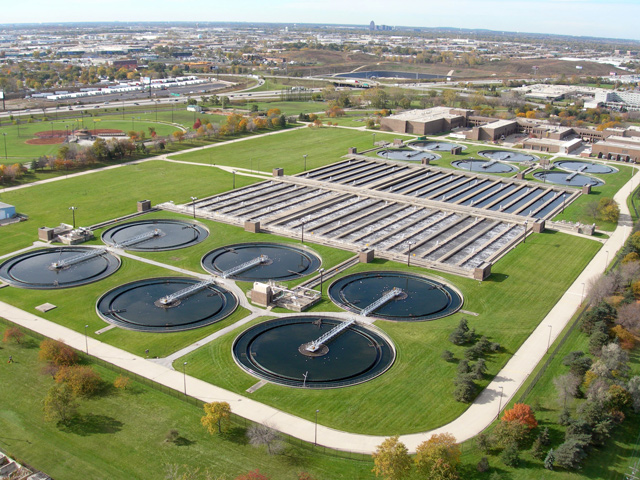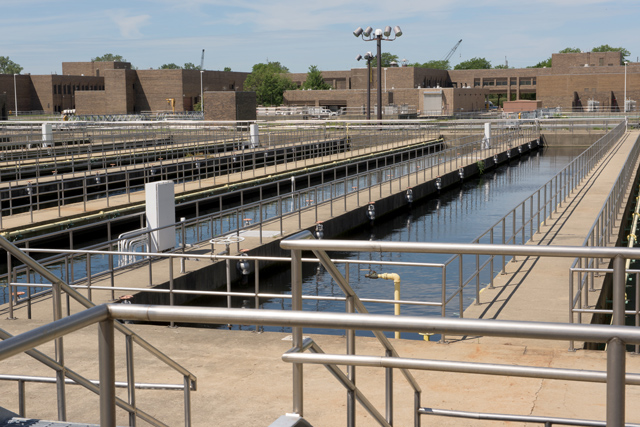James C. Kirie Water Reclamation Plant

Completed in May 1980 and located in Des Plaines, the Kirie Water Reclamation Plant (WRP) is the Metropolitan Water Reclamation District of Greater Chicago’s (MWRD) newest facility. The WRP is fully automated. From its computer control room, a single operator can monitor all plant processes and equipment, making it the first of all MWRD plants to provide this technology. Adjacent to the plant is the Majewski Metro Athletic Complex, operated by the Mount Prospect Park District and home to a field house and multiple soccer fields and baseball and softball diamonds.
This WRP serves a predominantly residential area with a population of approximately 264,000 covering a 65.2-square-mile serve area that includes Arlington Heights, Mount Prospect, Elk Grove Village, Prospect Heights, Wheeling, Buffalo Grove and parts of Rolling Meadows and Des Plaines. Kirie treats an average of 34 million gallons of water per day (mgd), but is designed to treat an average daily flow of 52 mgd and a maximum of 110 mgd.
The Kirie WRP has its own Tunnel and Reservoir Plan (TARP) system, which is independent of the Mainstream, Des Plaines and Calumet systems. The Kirie TARP is designed with the dual purpose of conveying dry weather flows to the plant and storing excess flows during rainstorms.
Wastewater entering the Kirie WRP passes through coarse screens (primary treatment) to filter out large debris prior to pumping. Coarse screening protects the pumps from being damaged by large debris. After pumping, the wastewater flows through additional primary treatment processes such as fine screens and aerated grit tanks where finer inorganic debris is removed and hauled off to landfills. Kirie was intentionally designed without primary treatment tanks in order to improve the efficiency of its secondary treatment system. In secondary treatment, microorganisms remove organic material from the water as oxygen is pumped into aeration tanks. Solids then settle at the bottom and clean water flows out the top of secondary settling tanks.
The water then enters the tertiary process where it is disinfected by injecting chlorination and dechlorination chemicals, filtered by sand filtration and finally aerated via post-aeration tanks. These tertiary processes add a final layer of protection from any contaminants. Clean water that has passed through the WRP treatment processes is released from the Kirie WRP into Higgins Creek. The whole process of converting raw sewage into clean water takes an average of about 24 hours from the time it enters the plant to being processed, cleaned and released, a fraction of the time it would take in a natural waterway.
Water treatment at Kirie has also led to new innovation in resource recovery. The constant temperature of treated water leaving the WRP, it turns out, provides an ideal heat transfer source for managing the plant’s heating and cooling. Although this technology was already established, what makes Kirie’s approach novel is its application. Treated water at Kirie runs at a near constant 55°F, creating what staff calls a “sewerthermal” production that can make this heat source available for transfer. The sewerthermal heat pumps extract heat from the treated water in the winter and in the summer dump heat for cooling. The system employs an evaporator and a condenser, with those two components switching direction based on time of year. It is the same concept as traditional geothermal without the expense of deep drilling.
The Illinois Clean Energy Community Foundation helped fund nearly half of the overall cost of the project through a grant and chemical engineers from the University of Illinois at Chicago have partnered in providing technical support. The savings at the plant include up to 50 percent reduction in electricity usage for heating and cooling needs since the only power needed is for the pumps. Estimates suggest the new system will use 20 percent or less power than what is needed for a traditional direct heating system. Decreased maintenance expenses and pollutants associated with separate heating and cooling systems are also expected. The MWRD estimates a full return on its financial investment in less than eight years on this unique geothermal energy recovery project.
To learn more about Kirie WRP, visit here.

| National Association of Clean Water Agencies | |
2018 |
Platinum Award for 100% Compliance with National Pollutant Discharge Elimination System Effluent Standards. |
2017 |
Platinum Award for 100% Compliance with National Pollutant Discharge Elimination System Effluent Standards. |
2016 |
Platinum Award for 100% Compliance with National Pollutant Discharge Elimination System Effluent Standards. |
2015 |
Platinum Award for 100% Compliance with National Pollutant Discharge Elimination System Effluent Standards. |
2014 |
Platinum Award for 100% Compliance with National Pollutant Discharge Elimination System Effluent Standards. |
2013 |
Platinum Award for 100% Compliance with National Pollutant Discharge Elimination System Effluent Standards. |
2012 |
Platinum Award for 100% Compliance with National Pollutant Discharge Elimination System Effluent Standards.. |
2011 |
Platinum Award for 100% Compliance with National Pollutant Discharge Elimination System Effluent Standards. |
2010 |
Platinum Award for 100% Compliance with National Pollutant Discharge Elimination System Effluent Standards. |
2009 |
Platinum Award for 100% Compliance for more than 5 years with National Pollutant Discharge Elimination System Effluent Standards. |
2008 |
Gold Award for 100% Compliance with National Pollutant Discharge Elimination System Effluent Standards. |
2007 |
Gold Award for 100% Compliance with National Pollutant Discharge Elimination System Effluent Standards. |